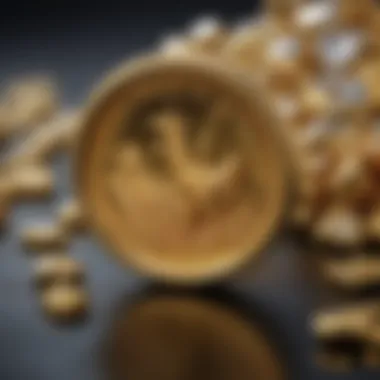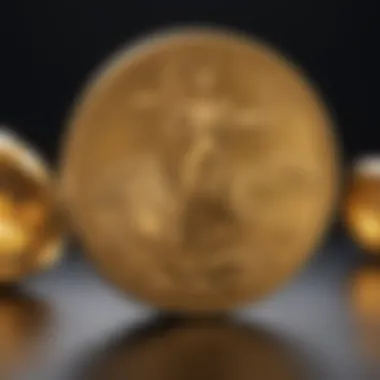Understanding 18K Gold Value: Pricing Per Gram Insights


Intro
Understanding the market value of 18K gold per gram is critical for those involved in jewelry making, investing, and collecting. Gold has been a symbol of wealth and security for centuries. The composition of gold, particularly the 18K variety, plays a significant role in its valuation. This article aims to explore several facets that contribute to the pricing of 18K gold, including its chemical properties, market behaviors, and economic indicators.
Overview of Gemstones and Minerals
Gold, as a mineral, holds a unique status among gemstones. Its importance stretches back to ancient civilizations and remains relevant today. The allure of gold is not merely its physical presence but its historical and cultural significance.
History of Gemstone and Mineral Use
Historically, gold has been utilized for various purposes, from currency to decorative pieces. Its rarity and beauty have made it a favored material. Ancient Egyptians, for instance, crafted intricate designs using gold for pharaohs' tombs, indicating its importance in society statuses.
Significance in Culture and Society
Gold's role in culture cannot be overstated. It has been used in religious artifacts, royal regalia, and traditional jewelry across numerous societies. Such items serve as indicators of wealth, power, and, in some cases, eternal life.
The Characteristics of 18K Gold
18K gold consists of 75% pure gold and 25% other metals like copper or silver. This composition not only affects its color but also its durability compared to other purities such as 10K or 24K gold. Understanding its properties is essential for evaluating its worth effectively.
Composition and Alloys
The combination of pure gold with metals like copper creates an alloy that is both resilient and aesthetically pleasing. The resulting hue can range from yellow to rose gold, depending on the metal used. Each alloy can influence the market demand and pricing.
Market Trends Affecting Value
The market value of 18K gold changes in response to various factors:
- Global economic conditions: Economic stability often leads to demand for gold as a safe asset.
- Industrial applications: Gold is used not just in jewelry but also in electronics, which can affect supply.
- Cultural trends: Fashions change, and so do consumer preferences for specific gold types.
As investors and consumers, being aware of these trends is essential in determining value.
Practical Implications for Investors
For investors and collectors, knowing how to evaluate the value of 18K gold per gram is important. Not only does one need to consider market prices, but also the purity level and craftsmanship involved in jewelry pieces. Understanding valuation methods can help in making informed decisions.
Evaluating 18K Gold Value
When assessing 18K gold, consider:
- Current market price: Check reliable sources for updated prices per gram.
- Condition of the item: Jewelry pieces should be thoroughly assessed for wear and structural integrity.
- Authenticity: Ensuring the piece is authentic is crucial for valuation.
It is advisable to consult with certified jewelers or valuation experts for precise appraisals.
The End
Prolusion to Gold Purity
Gold purity is fundamental when discussing the value of 18K gold per gram. Understanding purity affects not only the valuation of gold itself but also its applications in jewelry and the investment market. Higher purity in gold indicates a greater content of gold compared to other metals in an alloy, which influences overall quality, durability, and market price. This section serves as a crucial starting point for anyone looking to grasp why certain purities are favored and how they impact various aspects of gold transactions.
Definition of Gold Karats


The term "karat" is a measurement of gold purity. One karat signifies one part per 24. In practical terms, 24K gold is considered pure gold. Therefore, 18K gold means that it contains 18 parts gold and 6 parts other metals, which represent 75% gold content. This measurement gives consumers an easy way to determine the quality of gold they are purchasing. The higher the karat number, the purer the gold, but also, the more malleable and softer it is. Understanding karats enables buyers to make informed choices about what level of purity suits their needs, whether aesthetic, functional, or investment-based.
Understanding 18K Gold
Composition and Alloy Mix
18K gold comprises 75% gold, with the remaining 25% made up of other metals like copper, silver, or palladium. This alloy mix not only enhances the durability of gold but also allows for a range of colors and finishes. The addition of metals can impart different hues to gold. For instance, mixing with copper results in rose gold, while white gold is produced with metals like palladium or nickel. This versatility is why 18K gold is a popular choice among jewelry designers and consumers alike. The unique feature of 18K gold lies in its balance between purity and durability; it maintains a desirable sheen while providing robustness against daily wear and tear.
Comparative Analysis with Other Gold Types
When comparing 18K gold with other types, such as 14K and 24K, it's essential to consider both composition and market desirability. 14K gold has a lower gold content of 58.3%, making it less expensive but also less rich in color than 18K. Conversely, 24K gold, while purely gold, lacks strength and can scratch easily. Therefore, 18K gold stands out because it offers a middle ground: it provides the beauty and prestige of high-purity gold while also being practical for everyday use. This characteristic makes it particularly beneficial for fine jewelry, which often needs to withstand various conditions without losing its luster. However, potential buyers should also note that 18K gold may be more prone to tarnishing or scratching compared to lower karats, which is a disadvantage of its higher purity level.
Market Dynamics Influencing Gold Prices
Understanding the market dynamics that influence gold prices is crucial for anyone engaged with 18K gold. The pricing is not solely based on the metal itself; several factors shape its valuation. By exploring market dynamics, investors gain insights into the selling and buying patterns, which can impact their investment decisions.
These dynamics are multifaceted. They encompass supply and demand factors, broader economic indicators, and geopolitical influences. Each element plays a distinct role in forming the current value per gram of gold.
Supply and Demand Factors
Mine Production Rates
Mine production rates are a key component in shaping gold prices. The quantity of gold that is mined impacts supply levels, which can lead to fluctuations in market value. When mine production increases, the availability of gold rises, often leading to lower prices. Conversely, a decline in production typically creates scarcity, which can drive prices higher.
The primary characteristic of mine production is its variability. Factors like labor strikes, political instability, or geological challenges can disrupt production. This unpredictability serves as a beneficial element in understanding pricing trends.
One unique feature of mine production rates is that it does not operate in isolation. The interconnectedness with global markets means that changes in one region can ripple through to affect prices worldwide. The advantage of recognizing these patterns lies in the ability to anticipate shifts in pricing based on production forecasts.
Consumer Demand Trends
Consumer demand trends are another critical element affecting gold pricing. In times of economic uncertainty, consumers often flock to gold as a safe asset. Increased demand can lead to higher prices, reflecting the urgency among buyers to acquire gold.
The key characteristic of consumer demand is its cyclical nature. Seasonal trends and cultural celebrations can spike demand significantly. For example, jewelry consumption typically rises during wedding seasons or festivals, resulting in price surges during these periods.
A unique aspect of consumer demand trends lies in its responsiveness to economic signals. When economies strengthen, demand may drop as investors look elsewhere for higher returns. This duality presents both advantages and disadvantages in understanding gold's value. It underscores the importance of both supply-side and consumer perspectives in the art of pricing 18K gold.
Global Economic Indicators
Global economic indicators serve as essential tools for analyzing gold prices. These indicators include inflation rates, employment statistics, and monetary policy decisions from central banks. The relationship between these factors and gold pricing is intricate yet fundamental.
For instance, high inflation often leads to increased gold buying as investors seek to protect their wealth. Similarly, low-interest rates can drive more people toward gold as a viable alternative to earning interest from savings or bonds. Understanding these indicators allows investors to make more informed decisions about the timing of their purchases or sales in the gold market.
Geopolitical Influences
Geopolitical influences cannot be overlooked when discussing gold prices. Events such as political unrest, trade wars, and changes in government policy can trigger sudden shifts in demand and, consequently, prices. Gold has historically been viewed as a crisis commodity; as such, its value may spike during periods of uncertainty.
The key characteristic of geopolitical influences is their unpredictability. For instance, a conflict in a major gold-producing country could disrupt supply chains, impacting availability and price significantly. This unpredictability highlights the need for vigilance among gold investors, as changes can occur without warning.
By understanding the full scope of market dynamics, investors can navigate the complex landscape of gold pricing. Keeping abreast of mine production trends, consumer demand patterns, economic indicators, and geopolitical events is essential for making sound investment decisions.
Current Pricing Trends of 18K Gold
Understanding current pricing trends is crucial when analyzing the value of 18K gold per gram. The price of gold fluctuates based on a wide range of factors, making it essential for investors and consumers to keep abreast of these changes. The interaction between market dynamics, economic health, and geopolitical influences contributes to the valuation of gold. Observing these trends can provide insights into where gold prices might head in the future.


Recent Price Fluctuations
In recent months, the price of 18K gold has experienced significant fluctuations. Prices may rise sharply during economic instability or global crises. For instance, during the past year, it has seen both peaks and troughs. These shifts can be traced back to various global developments, including changes in monetary policy and altering currency values. Investors often react to these changes, which leads to volatility in the gold market.
- Seasonal Effects: Demand for gold often spikes during certain seasons, such as holidays.
- Technological Influence: Innovations in mining or recycling may also impact supply and prices.
Keeping track of these trends helps buyers determine the best times to invest or sell.
Historical Context for Price Changes
To better understand the current pricing of 18K gold, it is helpful to look at historical trends. The price of gold has seen a long-term upward trajectory. Historical events, like the 2008 financial crisis and the COVID-19 pandemic, have created spikes in gold prices.
- Long-term Growth: Since the 1970s, gold has generally appreciated in value.
- Recession Indicators: Historically, economic downturns lead to increased gold sales and higher prices.
Analyzing these events provides context for anticipating future price movements.
Impact of Market Speculation
Market speculation plays a significant role in determining the price of 18K gold. Investors are often influenced by predictions regarding inflation and economic recovery. If investors believe that inflation will rise, they tend to flock to gold as a safe haven, which increases demand and subsequently drives up prices.
- Speculative Buying: Traders often buy gold anticipating future price increases.
- Diverse Market Sentiment: Various factors, from political tension to currency fluctuations, may sway investor confidence in gold.
The speculative nature of the market complicates the pricing but also creates opportunities for informed investors.
In summary, the pricing trends of 18K gold are shaped by a combination of recent fluctuations, historical contexts, and speculative activities in the market. This understanding aids stakeholders in making prudent decisions about their investments.
Calculating the Price of 18K Gold Per Gram
Calculating the price of 18K gold per gram is a fundamental aspect of understanding its value. This section emphasizes the importance of accurate pricing mechanisms in the gold market. Knowing how to calculate the price accurately allows consumers, investors, and jewelers to make informed decisions.
Accurate pricing reflects the current market conditions and helps potential buyers evaluate their purchases against fluctuations in demand and supply. A comprehensive understanding of calculation strategies not only enriches individual knowledge but can also lead to better investment outcomes.
Estimation Techniques
Using Current Spot Prices
Using current spot prices is a commonly accepted method for valuing 18K gold. The spot price represents the current market value per ounce for gold and fluctuates due to various factors, including geopolitical situations and market demand. Its key characteristic is its immediacy; it provides a real-time figure that is easily accessible from multiple financial platforms.
Using current spot prices for calculating 18K gold provides a direct reference point for buyers. It is beneficial because it simplifies the valuation process, allowing consumers to quickly determine approximate value without extensive calculations. However, one unique feature of this method is its volatility; as the gold market can rapidly change, the quoted price may not reflect a future purchasing scenario. Hence, caution is advised when using spot prices alone for long-term investment decisions.
Calculating Based on Purity Levels
Calculating based on purity levels is another significant method of determining the price of 18K gold. This approach focuses on the actual gold content in a piece of jewelry. Since 18K gold consists of 75% pure gold, calculating its value involves understanding its purity versus other common types like 14K or 22K gold. The key characteristic here is precision, as it allows differentiated pricing based on the gold content.
This method is popular because it caters directly to the actual value of the metal in specific items. A unique feature is its ability to cater to varying gold purities; thus, it provides a clear understanding of how much gold one is truly paying for. The downside, however, lies in the fact that accurately assessing purity requires expertise, which may expose novice buyers to misvalued products unless they have reliable resources to consult.
Practical Examples
Practical examples help to illustrate how these calculations can be performed in real scenarios.
- Example with Current Spot Price: If the current spot price of gold is $1,800 per ounce, you can convert this to a per gram price (1 ounce = 28.3495 grams), resulting in approximately $63.57 per gram. For 18K gold, multiply this figure by 0.75 to find the price per gram of 18K gold, which in this scenario is about $47.68.
- Example with Purity Calculation: If you have a piece of 18K gold jewelry weighing 10 grams, the weight of pure gold in it would be 7.5 grams (10g x 0.75). If the current spot price is $63.57, then the value of the gold in that jewelry would be around $478.24 (7.5g x $63.57).
These calculations illustrate just how critical understanding pricing techniques is for anyone interested in gold, whether for investment purposes or personal collections. Through accurate methodologies, stakeholders can ensure they are fully aware of the value they are engaging with in the gold market.


Investment Considerations for 18K Gold
Investing in 18K gold offers a nuanced consideration for those looking to add value to their portfolios. Unlike lower-karat gold, which may contain higher percentages of base metals, 18K gold retains a significant amount of pure gold while still being durable enough for everyday wear. This balance makes it a compelling option for both collectors and investors.
Investors must assess their financial goals and risk tolerance when considering 18K gold. The market for this precious metal can be volatile, influenced by various factors such as global economic shifts and market speculation. Understanding these dynamics is crucial for making informed decisions. In this section, we will explore long-term and short-term investment strategies and the role of diversification in gold investments.
Long-term vs Short-term Investments
When contemplating investments in 18K gold, one must weigh the merits of long-term versus short-term strategies. Long-term investments typically involve purchasing gold with the expectation that its value will increase significantly over time. For many, 18K gold serves as a reliable store of value during economic instability. Historically, gold prices have shown resilience, making it an appealing option for investors looking to hedge against inflation and currency fluctuations.
On the other hand, short-term investments in 18K gold can take advantage of market fluctuations. This strategy involves buying and selling gold within a shorter timeframe, aiming to profit from price changes. However, this approach requires a keen understanding of market trends and can be riskier. A periodic assessment of gold prices and market sentiment can aid in making timely decisions.
Diversification in Gold Investments
Diversification is an essential strategy for any investment portfolio, including those focused on gold. By spreading investments across different assets, investors can mitigate risks associated with market volatility. For those investing in 18K gold, incorporating various types of gold products, such as bullion, coins, and jewelry, can be an effective way to diversify.
Additionally, investors may consider pairing gold investments with other assets, such as stocks or bonds. This blend helps cushion against the specific risks posed by each asset. Diversifying within gold investments itself can also be beneficial. For example, combining 18K gold items with lower-karat gold, silver, or even platinum can enhance overall portfolio stability.
Investing in 18K gold is not just about buying and holding; it requires a strategic approach to align with your financial goals.
Implications for Jewelry and Collectibles
Understanding the implications of 18K gold in jewelry and collectibles is essential for both consumers and investors. Its value not only stems from the gold itself but also from its applications in various forms of art and craftsmanship. With a market that constantly evolves, being informed about these implications pays off in the long run.
Understanding Jewelry Valuation
Jewelry valuation is a complex process that takes into account multiple factors. Key elements include the market demand, the quality of materials, and the artistry involved. When valuating jewelry that includes 18K gold, the following aspects are critical:
- Purity Level: The 18K mark indicates 75% gold content, which affects the overall value significantly compared to lower karat grades.
- Craftsmanship: Intricate designs and skilled craftsmanship can elevate the price of the piece. This includes the setting of stones and the overall aesthetic appeal.
- Brand Value: Renowned brands such as Tiffany & Co. or Cartier tend to hold their value better due to reputation.
These factors make 18K gold jewelry more appealing to collectors. As a result, its valuation often appreciates over time, making it a worthwhile investment.
Role of Gold in Gemstone Settings
Gold, specifically 18K gold, plays a crucial role in gemstone settings. Its properties, both mechanical and aesthetic, are important for several reasons:
- Durability: Compared to pure gold, which is soft, 18K gold provides a stronger base for setting gemstones. This durability helps in maintaining the integrity of the jewelry.
- Aesthetic Appeal: The yellow hue of 18K gold enhances the vibrancy of colored gemstones while providing a classic yet modern look. This harmony between gold and gemstones is often what attracts consumers.
- Market Trends: As styles change, the preference for certain gold shades may shift. 18K gold has stood the test of time and remains a favored choice among jewelers.
In summary, the implications of 18K gold extend beyond mere value. They intertwine with artistry, market trends, and consumer preferences. Anyone interested in jewelry or collectibles should grasp these nuances for informed decisions.
Ending and Future Outlook
The conclusion and future outlook for the value of 18K gold per gram is pivotal in understanding the broader implications for stakeholders in the precious metals market. The section wraps up the analyses and insights discussed throughout the article, providing a summation that can guide potential actions for investors and consumers alike.
It is essential to note that the valuation of 18K gold is not merely a reflection of its composition but a complex interplay of market forces, economic indicators, and consumer behavior. As gold pricing remains highly dynamic, staying informed about market trends can significantly enhance decision-making processes.
Predicted Trends in Gold Pricing
Predicting future trends in gold pricing requires a careful examination of various indicators. Analysts often look at:
- Supply Chain Dynamics: Changes in mine production rates can impact availability and pricing. If large mines face reductions in output, the scarcity might push prices higher.
- Economic Performance: Inflation, interest rates, and fiscal policies can all influence gold's attractiveness as a safe haven. In uncertain economic times, demand for gold often rises, affecting its price positively.
- Geopolitical Tensions: Events such as conflicts or trade disputes can alter market dynamics. Gold typically gains value during geopolitical instability as investors seek security.
Market analysts predict a potential increase in 18K gold prices, driven by these factors, but vigilance is necessary. Price fluctuations can be unpredictable.
Final Thoughts on 18K Gold Investments
Investors should approach 18K gold with a comprehensive strategy. The allure of a tangible asset like gold cannot be overstated. However, several considerations are vital:
- Long-Term Value: Unlike many investments, gold can serve as a hedge against inflation. Owning 18K gold jewelry or investments may provide stability amid market volatility.
- Diversification: Integrating 18K gold into a broader investment strategy can mitigate risks associated with market fluctuations.
- Market Monitoring: Keeping an eye on gold market trends can inform timely buying or selling decisions, optimized by price changes and economic conditions.







